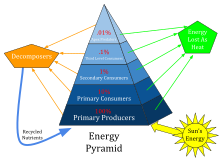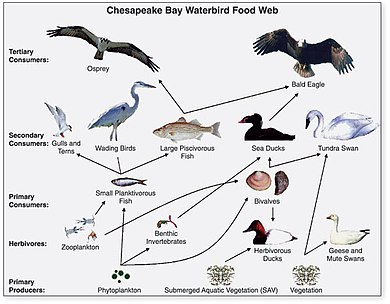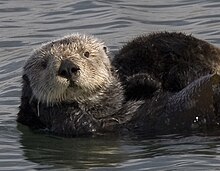Food chain
A food chain is a linear network of links in a
Food chain studies play an important role in many biological studies.
Food chain stability is very important for the survival of most species. When only one element is removed from the food chain it can result in extinction or immense decreases of survival of a species. Many food chains and food webs contain a keystone species, a species that has a large impact on the surrounding environment and that can directly affect the food chain. If a keystone species is removed it can set the entire food chain off balance.[1]
The efficiency of a food chain depends on the energy first consumed by the primary producers.[2] This energy then moves through the trophic levels.
History
Food Chains were first discussed by al-Jahiz, a 10th century Arab philosopher.[3] The modern concepts of food chains and food webs were introduced by Charles Elton.[4][5][6]
Food Chain vs. Food Web
A food chain differs from a food web as a food chain follows a direct linear pathway of consumption and energy transfer. Natural interconnections between food chains make a food web, which are non-linear and depict interconnecting pathways of consumption and energy transfer.
Trophic Levels
Food chain models typically predict that communities are controlled by predators at the top and plants (autotrophs or producers) at the bottom.[7]

Thus, the foundation of the food chain typically consists of
Higher
At the highest trophic level is typically an apex predator; a consumer with no natural predators in the food chain model.
When any trophic level dies, detritivores and decomposers consume their organic material for energy and expel nutrients into the environment in their waste. Decomposers and detritivores break down the organic compounds into simple nutrients that are returned to the soil. These are the simple nutrients that plants require to create organic compounds. It is estimated that there are more than 100,000 different decomposers in existence.
Models of trophic levels also often model energy transfer between trophic levels. Primary consumers get energy from the producer and pass it to the secondary and tertiary consumers.
Studies
Food chains are vital in
Length

The length of a food chain is a
Food chains are directional paths of trophic energy or, equivalently, sequences of links that start with basal species, such as producers or fine organic matter, and end with consumer organisms.[11]: 370
Food chains are often used in
In its simplest form, the length of a chain is the number of links between a trophic consumer and the base of the web. The mean chain length of an entire web is the arithmetic average of the lengths of all chains in the food web.[13] The food chain is an energy source diagram. The food chain begins with a producer, which is eaten by a primary consumer. The primary consumer may be eaten by a secondary consumer, which in turn may be consumed by a tertiary consumer. The tertiary consumers may sometimes become prey to the top predators known as the quaternary consumers. For example, a food chain might start with a green plant as the producer, which is eaten by a snail, the primary consumer. The snail might then be the prey of a secondary consumer such as a frog, which itself may be eaten by a tertiary consumer such as a snake which in turn may be consumed by an eagle.
Ecologists have formulated and tested hypotheses regarding the nature of ecological patterns associated with food chain length, such as length increasing with ecosystem volume,[14] limited by the reduction of energy at each successive level,[15] or reflecting habitat type.[16]
Food chain length is important because the amount of energy transferred decreases as trophic level increases; generally only ten percent of the total energy at one trophic level is passed to the next, as the remainder is used in the
Keystone Species

A keystone species is a singular species within an ecosystem that other species within the same ecosystem, or the entire ecosystem itself, rely upon.[19]Keystone species' are so vital for an ecosystem that without their presence, an ecosystem could transform or stop existing entirely. [19]
One way keystone species impact an ecosystem is through their presence in an ecosystem's food web and by extension, a food chain within said ecosystem.[20] For instance, sea otters, a keystone species in pacific coastal regions, prey on sea urchins.[21] Without the presence of sea otters, sea urchins practice destructive grazing on kelp populations which contributes to declines in coastal ecosystems within the northern pacific regions.[21] The presence of sea otters in turn, controls sea urchin populations and helps maintain kelp forests, which are vital for other species within the ecosystem.[19]
See also
- Heterotroph
- Lithotroph
- Ecological pyramid
- Predator-prey interaction
References
- ^ "The Food Chain". www2.nau.edu. Retrieved 2019-05-04.
- ^ .
- ISBN 978-1-4020-8866-7.
- ISBN 0-226-20639-4.
- S2CID 11536563. Archived from the original(PDF) on 2016-05-15.
- .
- ^ PMID 11607368.
- ^ US Department of Commerce, National Oceanic and Atmospheric Administration. "What is the difference between photosynthesis and chemosynthesis?: Ocean Exploration Facts: NOAA Ocean Exploration". oceanexplorer.noaa.gov. Retrieved 2024-04-15.
- JSTOR 3565489.
- S2CID 4424697. Archived from the original(PDF) on 2016-03-04. Retrieved 2011-06-14.
- JSTOR 2937047.
- .
- PMID 16844774.
- PMID 3672136. Archived from the original(PDF) on 2012-04-25.
- ISBN 978-0-534-42066-6.
- ^ Briand, Frederic (Oct 1983). "Biogeographic Patterns in Food Web Organization". Oak Ridge National Laboratory Reports. ORNL-5983: 37–39.
- CK-12. Retrieved 2019-11-06.
- ^ Rafferty, John P.; et al. (Kara Rogers, Editors of Encyclopædia Britannica). "Food chain". Food chain | Definition, Types, & Facts. Encyclopædia Britannica. Retrieved 2019-10-25.
- ^ a b c Sidhu, Jatinder (2021-09-16). "What is a keystone species, and why do they matter?". World Economic Forum.
- PMID 19451124.
- ^ a b Park, Mailing Address: Glacier Bay National; Gustavus, Preserve PO Box 140; Us, AK 99826 Phone: 907 697-2230 Contact. "A Keystone Species, the Sea Otter, Colonizes Glacier Bay - Glacier Bay National Park & Preserve (U.S. National Park Service)". www.nps.gov. Retrieved 2024-04-15.
{{cite web}}: CS1 maint: numeric names: authors list (link)
